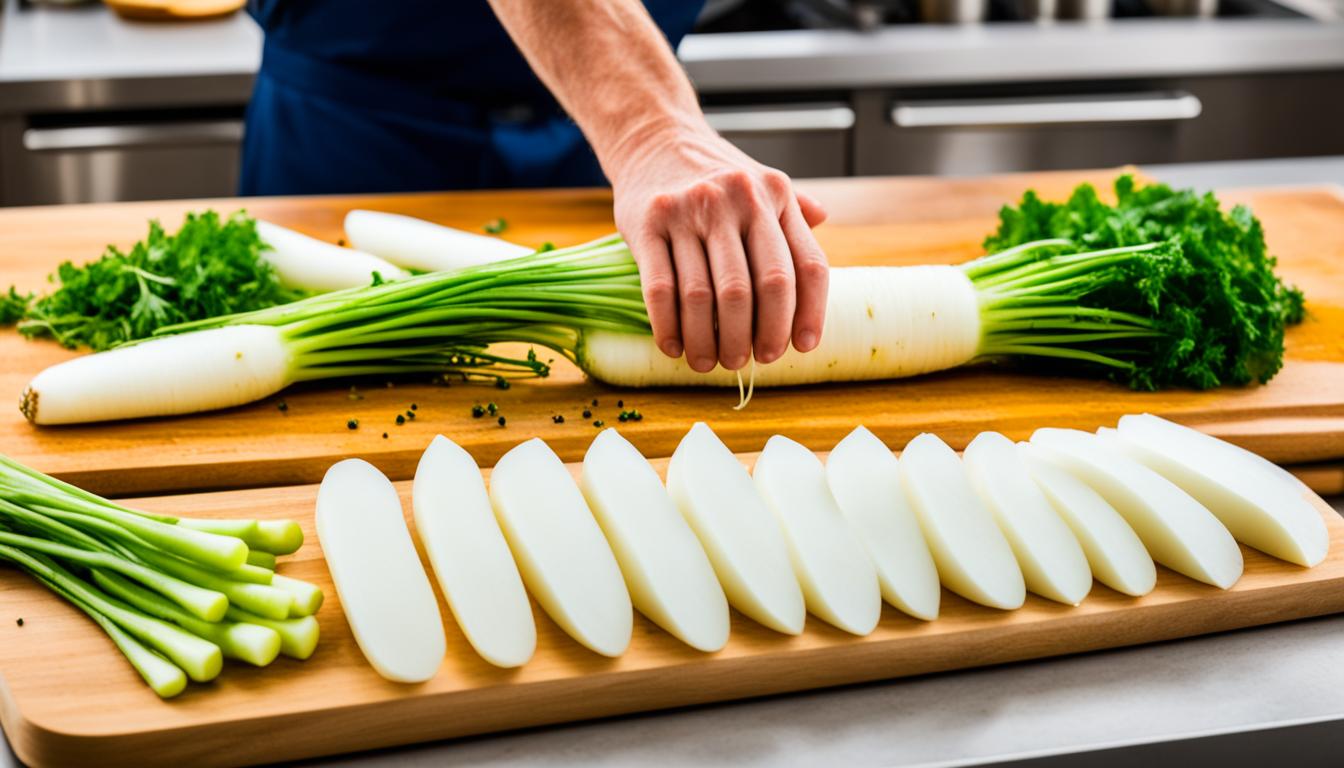Have you ever wondered how to make your own danmuji, the delicious Korean pickled daikon radish? Forget the store-bought versions with added preservatives and food coloring. With our homemade danmuji recipe, you can enjoy this tangy and vibrant side dish whenever you want!
Danmuji is a traditional Korean pickle known for its bright yellow color and refreshing taste. It is commonly eaten inside kimbap and served alongside noodle dishes like jjajangmyeon. But why settle for store-bought when you can easily make it at home?
Making danmuji is a simple and easy process. All you need are some basic ingredients like rice vinegar, garlic, turmeric, bay leaves, and black peppercorns. These flavors come together to create the perfect balance of sweetness and acidity in the pickles.
To ensure the radish is fully pickled, it is cut into strips or thin rounds and submerged in a brine made from the vinegar mixture. We even have a tip to make sure the radish is fully submerged for more effective pickling. Can you guess what it is?
After the pickles have cooled to room temperature, they are transferred to an airtight glass container and stored in the refrigerator. This way, you can enjoy homemade danmuji for up to a month!
Stay tuned for our step-by-step guide on how to make danmuji at home. You’ll be amazed at how easy it is to create this delicious Korean side dish.
Traditional Korean Danmuji and Its Uses
Traditional Korean danmuji is a versatile ingredient that enhances the flavors and textures of various Korean dishes. Its vibrant yellow color and tangy taste make it a popular side dish and condiment.
One of the most well-known uses of danmuji is in kimbap, a delicious Korean rice roll wrapped in nori. The pickled radish adds a refreshing crunch and tangy flavor to the rolls, balancing the richness of the fillings. Whether it’s a classic kimbap with vegetables or a creative fusion roll, danmuji brings a unique element to the dish.
Aside from being a staple in kimbap, danmuji is also commonly served as a side dish alongside noodle dishes like jjajangmyeon. Its bright and refreshing taste complements the rich flavors of the noodles, offering a delightful contrast.
Beyond kimbap and noodle dishes, danmuji finds its way into another iconic Korean dish – bibimbap. This vibrant rice bowl topped with an array of vegetables, meat, and a fried egg comes to life with the addition of this pickled radish. The tanginess and pop of color elevate the overall flavor profile of the dish, making it a favorite among bibimbap enthusiasts.
With its versatility and unique flavor, traditional Korean danmuji has become an essential component in Korean cuisine. Whether enjoyed as a side dish, condiment, or part of a larger dish, danmuji adds a delightful touch to the dining experience.
Next, we’ll guide you through the step-by-step process of making your own danmuji at home. Stay tuned!
Step-by-Step Guide to Making Danmuji at Home
To create your own easy danmuji pickled radish, you’ll need a few simple ingredients. Start by gathering rice vinegar, water, sugar, salt, and turmeric. Once you have everything ready, it’s time to embark on this authentic danmuji recipe.
Begin by boiling the vinegar mixture, which consists of rice vinegar, water, sugar, salt, and turmeric. This flavorful blend will infuse the pickles with their distinct yellow color and tangy taste.
Next, carefully cut the daikon radish into strips or rounds. Place the radish in a large glass container, ensuring it’s large enough to hold all the pieces. Pour the boiled vinegar mixture over the radish, making sure that every piece is submerged. Seal the glass container with a lid to commence the pickling process.
Patience is key here. Allow the pickles to cool completely before transferring the container to the refrigerator. Let the magic happen over the next 24 hours as the flavors intensify and the radish pickles to perfection.
After the pickling period, you’ll be rewarded with your very own homemade danmuji. Revel in the perfect balance of sweetness and acidity, as this vibrant side dish adds a pop of color and crunch to any Korean meal. Enjoy it on its own or explore its versatility by incorporating it into various dishes.
With this easy danmuji recipe, you’ll be able to prepare approximately 2 quarts of pickled radish. Store it in the refrigerator for up to a month, ensuring its authentic flavors and signature yellow hue remain intact for future enjoyment. Embrace the art of homemade pickling and elevate your culinary repertoire with this Korean yellow pickled radish.
